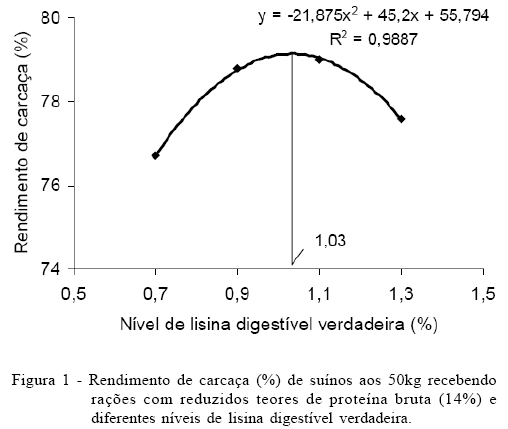The objective of this research was to evaluate the different levels of true digestible lysine (TDL) in diets with reduced crude protein (CP) level through to performance and carcass characteristics of pigs from 20 to 50kg. Forty barrows with high performance (initial weight of 22.50±1.4kg and final of 47.8±3.4kg), distributed in randomized block design with five treatments (four levels of TDL - 0.7, 0.9, 1.1 and 1.3% - in 14% CP diets - and a control treatment, formulated in accordance to Brazilian Tables, with 1.03% of TDL and 18% CP) and four replications during 31 days were utilized. There were no differences (P>0.05) between levels of TDL in diets with 14% CP for average daily gain; however, just the level of 0.7% of TDL was different of control treatment. There was no difference (P>0.05) on feed intake, but there was crescent linear effect (P<0.05) of the TDL levels on feed conversion in reduced CP diets. The lysine utilized efficiency to weight gain decrease (P<0.05) linearly with the increase of this amino acid. There was quadratic effect to carcass yield, Longissimus muscle area and meat:fat relation being 1.03; 1.00 and 1.09% the respective levels of TDL that resulted the best results in this CP level. With regard to the control treatment the levels of 0.9 and 1.1% of TDL shown bigger carcass yield. There was no difference (P>0.05) to backfat thickness. It was conclude that the level of 1.1% TDL in diets with reduced CP increase carcass yield without to modify the performance.
animal nutrition; carcass quality crystalline amino acid; nutritional requirements

 Performance and carcass characteristics of swine from 20 to 50kg receiving diets with reduced crude protein and different levels of true digestible lysine
Performance and carcass characteristics of swine from 20 to 50kg receiving diets with reduced crude protein and different levels of true digestible lysine


